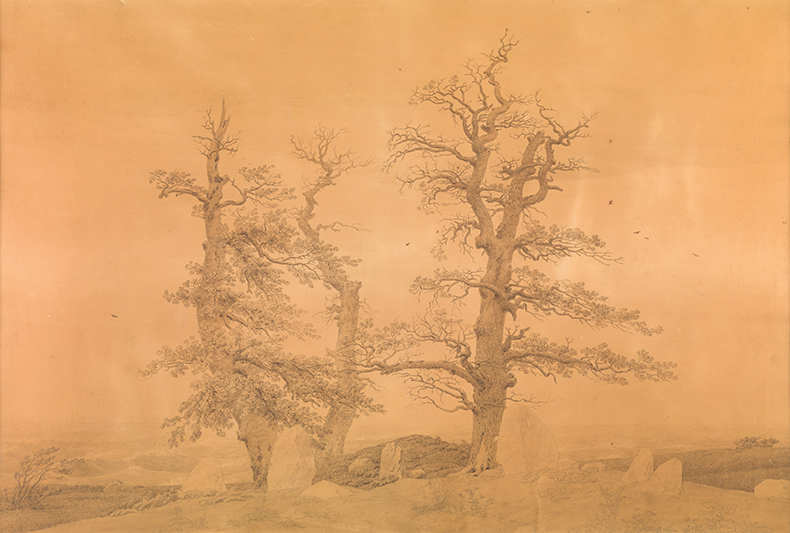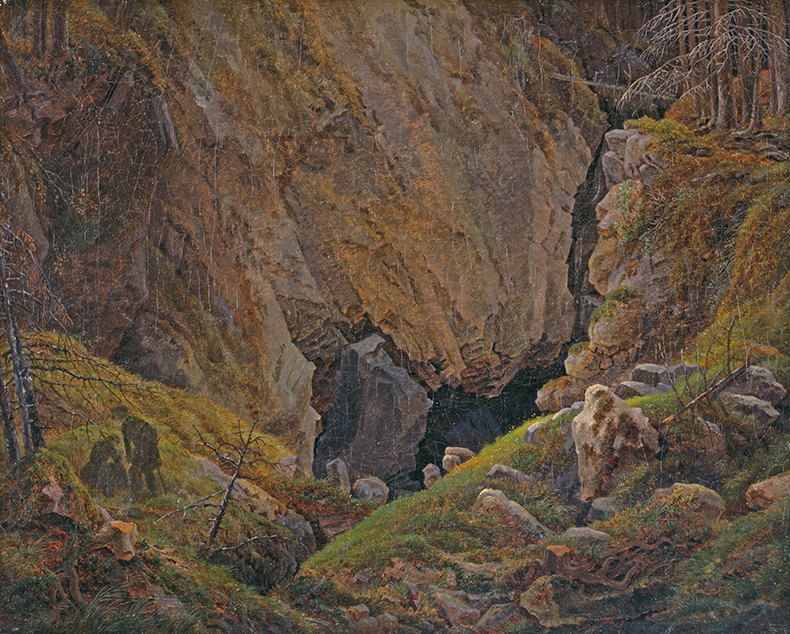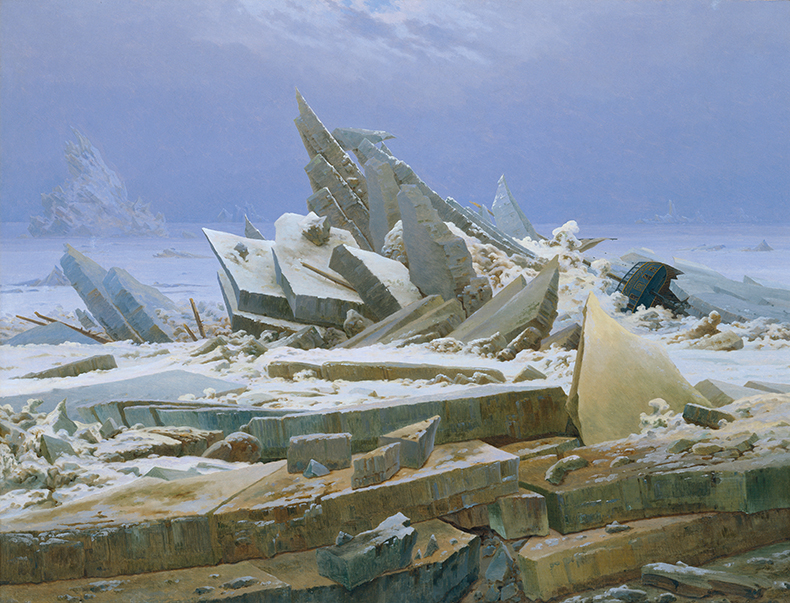From the June 2024 issue of Apollo. Preview and subscribe here.
As the pre-eminent painter of German Romanticism, Caspar David Friedrich (1774–1840) exemplifies the movement’s pursuit of spiritual and emotional communion with the natural world. Friedrich prioritised authenticity and self-expression over the imitation of Italian Renaissance masters – ‘I see everywhere the tiresome attempt to imitate Old Master paintings and engravings,’ he complained around 1830 – and it was through nature that he and his peers believed humankind might come into contact with the infinite and the divine: ‘Oh holy Nature! How oft must you yield to fashion and subject yourself to human rules?’ In place of traditional religious motifs, Friedrich painted environments that addressed universal themes through a deeply personal symbolic language.
Friedrich’s world and the environments he painted were also changing rapidly. In the first of a year of exhibitions in Germany marking the 250th anniversary of the artist’s birth, the Hamburger Kunsthalle called its Friedrich exhibition ‘Art for a New Age’. (Other exhibitions include the ‘Caspar David Friedrich: Infinite Landscapes’ at the Alte Nationalgalerie in Berlin until 4 August; ‘Caspar David Friedrich: Where it all Started’ in Dresden, from 24 August–5 January 2025 and a trio of exhibitions at the Pommersches Landesmuseum in Greifswald, ending on 5 January 2025.) The Hamburger Kunsthalle’s title was apt. Friedrich lived through the rise and fall of the first French Republic, the collapse of the Holy Roman Empire and the secular consolidation of German territories. Urban centres grew rapidly as the continent transitioned from an agricultural to an industrial economy. In short, German Romanticism witnessed the emergence of European modernity. ‘Recognise yourself and the time in which you live,’ Friedrich had urged his fellow artists and his art met this new age with new visual forms, his landscapes flattening and simplifying the places they portrayed.

Chalk Cliffs on Rügen (1818), Caspar David Friedrich. Kunst Museum Winterhur. Photo: SIK-ISEA, Zürich/Philipp Hitz
More than two centuries have elapsed between Friedrich’s ‘new age’ and our own. Yet the artist has more to say to present-day viewers than is usually assumed. Although Friedrich sought out the universal within nature, he was acutely aware that nature was not static. The ore-rich mountains around Dresden, where he lived for most of his life, were a centre of industrial activity. Friedrich both observed and painted a natural environment that was being transformed in response to the needs of a carbonising European economy, the legacy of which is still with us today. We can return to Friedrich to reflect on what it means for humankind to embrace and to find meaning in a natural world that we have permanently altered.
Friedrich was born in 1774 in Greifswald, a city in northern Germany on the coast of the Baltic Sea. Greifswald was part of Sweden and had been for more than a century. It wasn’t until 1815 – when Friedrich had already reached artistic maturity – that the region was absorbed into the Kingdom of Prussia. The son of a skilled craftsman, Friedrich was raised as a devout Lutheran. His artistic training began in 1790 at the local university. There he would have been exposed to subjects such as civil engineering and the natural sciences. In 1794 he enrolled at the Academy of Copenhagen where he received a more traditional academic education. Four years later Friedrich journeyed south to Dresden. Although he travelled extensively through the German countryside in the years that followed, Dresden remained his base.
Friedrich’s initial training was in topographical draughtsmanship, a manner of drawing that prioritises the detailed and accurate transcription of a specific environment. It was a practice embraced by landscape artists but also by military draughtsman, cartographers and surveyors. In the early sepia drawings produced by Friedrich, we see the work of an astute and careful observer of nature. These drawings also portray a natural setting that is decidedly German. Academic landscape painting at the time took its cue from the Italian tradition, in which classical motifs were placed amid sun-drenched rolling hills and delicate trees. Friedrich’s landscape, in contrast, featured muscular oak trees in a sparse wintry terrain. There was no mistaking it for Italy.

Cairn by the Sea (c. 1806/07), Caspar David Friedrich. Klassik Stiftung Weimar. Photo: Alexander Burzik
Though they are based on the close study of nature, Friedrich’s paintings are never literal. The Abbey in the Oakwood (1809/10), one of his early landscapes in oil paint, combines the detailed portrayal of ancient oak trees with a religious meditation on death. In the shadowy foreground of a snowy landscape, monks carry a coffin under the archway of a ruined abbey. In the middle of the foreground, the space closest to the viewer, an open grave awaits. Above the figures, the broken window tracery of the abbey echoes the slim, bare branches of the oaks. The implication is that the landscape itself is in complete harmony with the spiritual realm (for Friedrich, an emphatically Christian realm). While the grave and the ruined abbey speak to the inevitable decay of all human things, the towering trees remind the viewer that nature will renew itself. Spring will come and spiritual salvation will come with it.
Friedrich’s modern sensibility can be glimpsed in the drastic simplicity of the composition and its desaturated treatment of colour. More than half of the canvas is given over to a blank, tonal expanse of sky punctuated only by a sliver of moon and silhouetted tree branches. The flattened landscape is exceptionally striking when we consider that Friedrich’s early training emphasised detail-rich portrayals of identifiable settings. Yet this is precisely what Friedrich has not produced. The painting supplies remarkably little information about the environment it depicts. Instead it suggests an infinite expanse, a world that extends indefinitely beyond the edges of the composition. In the artist’s own commentary on the painting he noted that its features ‘become increasingly indistinct lower down; the shapes become ambiguous as they approach the earth, until everything is lost in fog’. Like much of Friedrich’s art, the painting evokes rather than explains, leaving space for the viewer to feel and to reflect.

The Abbey in the Oakwood (1809/10), Caspar David Friedrich. Staatliche Museen zu Berlin, Alte Nationalgalerie. Photo: Andres Kilger
The oak tree featured in many of Friedrich’s paintings was a rich historical symbol of German national identity. It was also under threat of being displaced by new species of trees. In the late 18th century, German scientists pioneered a modern system of forest management that rapidly spread across Europe. Since the Thirty Years War (1618–48), which had been fought across Central Europe including much of what is now Germany, the supply of timber had been in crisis. Vast and reliable quantities of wood were needed to power energy-intensive industries that produced glass, iron and other valuable metals. Wood was the primary material used in construction and shipbuilding, the latter of which was especially important in an age of imperial expansion and warfare. Domestic heating likewise relied upon timber and wood charcoal. Europe couldn’t run without wood. Lots of it.
Protecting and regulating the supply of timber had become a matter of great concern to scientists as well as to state administrators. German foresters proposed dividing woodlands into smaller units of land and felling trees from one unit each year. By cycling through the woods to be cut down, the felled areas would have time to regrow before they were cut again. This new method required a new word: Nachhaltigkeit, or ‘sustainability’. An ideal woodland, from the perspective of German scientific forest management, would have trees of the same type and the same age. This would ensure a predictable quantity of timber generated by a given plot of land and would also yield wood with uniform density and water content; in other words, wood that was ideal for use in a furnace because it would generate a consistent heat.
There were a few obstacles that stood in the way of an ideal and economically productive forest. The first was people. For centuries rural communities had shared access to communal woodlands. They gathered brush wood for kindling, bark for tanning, thatch for roofs and fences, plants for food and medicine, and they let their animals graze on the undergrowth. It was believed that these practices damaged the woodlands and let them fall into a state of decline. The second obstacle was undergrowth, which might compete with high-yield trees for nutrients and water and which might attract harmful insects. A third obstacle was that German forests contained large quantities of oak and beech trees, species which grow slowly and are prone to irregular shapes.

Forest Interior by Moonlight (c. 1823–30), Caspar David Friedrich. Photo: Jörg P. Anders; © bpk – Photo Agency/Nationalgalerie, Staatliche Museen zu Berlin
We don’t know anything about Friedrich’s views on the subject, but it seems likely that he would have had some familiarity with the new science of forest management through his friend Gotthilf Heinrich von Schubert, who specialised in botany, forestry and geology. The woods of the Harz Mountains, of which Friedrich was particularly fond, were actively managed by a forest administration and had been the site of notable late 18th-century experiments. Whether or not the artist was aware of its underpinning scientific concepts, when Friedrich travelled through the countryside sketching he encountered a landscape that had been deliberately transformed over the preceding decades and that was continuing to change. Under the guidance of state-sponsored forest administration, new woods had been planted with spruce and pine trees. These coniferous species grew quickly and straight in German soil. They were planted at the same time and spaced at regular intervals to promote uniform growth. Restrictions limited the ability of rural communities to use woodlands for grazing and forest undergrowth was regularly cleared. That version of an ideal woodland – what we today call a timber plantation – appears in paintings such as Forest Interior by Moonlight (c. 1823–30). Tall, straight conifers are evenly spread rather than clustered together. Undergrowth is rarely seen. In the foreground, tree stumps attest to the cyclical harvesting of the woods and young saplings point towards their sustainable future. The painting embraces the beauty of modern, artificially planted woodlands.
We tend to think of German Romanticism as a movement devoted to exploring the emotional and spiritual aspects of landscape painting. While that is certainly true, we should recognise that Friedrich was also responding to the tangible and intangible effects of a rapidly industrialising economy. Dresden was close to Europe’s leading centre for the study of mining, the Freiberg Mining Academy. We don’t know if Friedrich visited the Mining Academy, although he was friends with men who studied there. Several of the most important German Romantic writers were even employed as mining administrators, including Goethe and Friedrich von Hardenberg (better known by his pen name, Novalis).

The Watzmann (1824/25), Caspar David Friedrich. Alte Nationalgalerie, Staatliche Museen zu Berlin. Photo: Andres Kilger
Mining and geology were popular topics of conversation in the educated circles of Dresden. The region’s economic prosperity was largely derived from mining and so too was the private wealth of many of its art patrons. Friedrich’s geological knowledge is on full display in his detailed rendering of different rock formations in his paintings, even though he was also willing to depart from geological accuracy in famous landscapes such The Watzmann (1824/25) in which he combined rock formations he knew to belong to different places.
The Harz Mountains, which Friedrich especially liked, were the site of extensive mining operations as well as a source of Romantic inspiration. Sometimes these activities coincided: in 1783 Goethe explored the Harz with his good friend Friedrich Wilhelm Heinrich von Trebra, one of the most influential mining administrators of the 18th century. (Von Trebra, like Friedrich, was based in Saxony in the first decades of the 19th century.) Friedrich’s paintings of the Harz Mountains do not portray the ore-mining industry. Instead, they pay close attention to the massive rock formations for which the region was known. In Rock Canyon in the Harz (1811/21), two figures pause outside of a deep recess within a mountain, embracing the Romantic dictum of immersing oneself in nature. The painting plays on the dissonant size of the massive rock face and the diminutive human figures who barely stand out from the grass upon which they rest.
Like Friedrich, we are coming to terms with a natural world that has been drastically altered by human industry. In a similar manner, we are compelled to question what the relationship between the human and the natural ought to be. In Friedrich’s most famous painting, Wanderer above the Sea of Fog (c. 1818), the titular figure looks out over a mountainous landscape shrouded in thick mist. The painting invokes the sense of visual mastery that comes from a high vantage point. It also serves as an appeal to the viewer to confront the sublime expanses of the natural world. With his body turned towards the landscape, the wanderer willingly exposes himself to its power.

Rock Canyon in the Harz (1811/21), Caspar David Friedrich. Photo: © Pommersches Landesmuseum, Greifswald resp. Pomeranian State Museum, Griefswald
The terrain that the wanderer actually sees, however, remains largely hidden from view. As the art historian Joseph Leo Koerner has argued, Friedrich’s landscapes can never be fully resolved and neither can our relationship to them. The detailed rendering of rock in the foreground is thrown into sharp relief by the hazy tonal formations that extend into the distance. There are limits to human vision and human knowledge, the composition suggests. Beyond the domain of the human lies a natural world to which we can only ever have partial access. In the artist’s discussion of The Abbey in the Oakwood noted above, Friedrich described himself as ‘attempting to depict […] that which is perceived and recognised only through faith, and will always remain a mystery to the finite knowledge of human beings’. Friedrich knew a great deal about the scientific study of nature. Yet he sought to portray that which lies beyond the limits of scientific knowledge. In that sense, the formal irresolution of the landscape the figure in Wanderer looks out upon is precisely the point.
To the extent that Friedrich is a painter for our age as well as his own, his art also sounds a note of caution. Take The Sea of Ice (1823/24), which depicts the wreckage of an Arctic expedition. Friedrich knew about William Edward Parry’s recent efforts to find the Northwest Passage, which had been closely followed by European newspapers. Press coverage tended to treat scientific explorations of the Arctic as emblems of human ambition and scientific progress, so portraying their failure in vivid detail issues a warning about the futility of trying to subdue nature. In The Sea of Ice, the wooden hull of a ship can be seen on the right, dwarfed by jagged slabs of rock-like ice that have crushed and absorbed the vessel, and thick sheets of ice in the foreground locate the viewer firmly within the Arctic landscape.
The artist was ambivalent about the moral virtue of humanity: ‘[Mankind] is the most sublime product of the whole of creation, but also the disfiguring stain in the created world,’ he observed in around 1830. Friedrich sought to bring the human into proximity with divine nature, but couldn’t help being aware of human endeavours to extract resources from nature, such as mining for ore and harvesting timber. Alongside this – perhaps, in the face of this – his art still invites us to immerse ourselves in a natural world whose totality will always lie beyond the limits of human knowledge.

The Sea of Ice (1823/24), Caspar David Friedrich. Photo: Elke Walford; © Hamburger Kunsthalle/bpk
‘Caspar David Friedrich: Infinite Landscapes’ is at the Alte Nationalgalerie in Berlin until 4 August; ‘Caspar David Friedrich: Where it all Started’ is at the Kupferstich-Kabinett (until 11 November) and the Albertinum (until 5 January 2015) in Dresden; and there is a trio of exhibitions at the Pommersches Landesmuseum in Greifswald, ending on 5 January 2025).
From the June 2024 issue of Apollo. Preview and subscribe here.














![Masterpiece [Re]discovery 2022. Photo: Ben Fisher Photography, courtesy of Masterpiece London](http://zephr.apollo-magazine.com/wp-content/uploads/2022/07/MPL2022_4263.jpg)
‘Like landscape, his objects seem to breathe’: Gordon Baldwin (1932–2025)